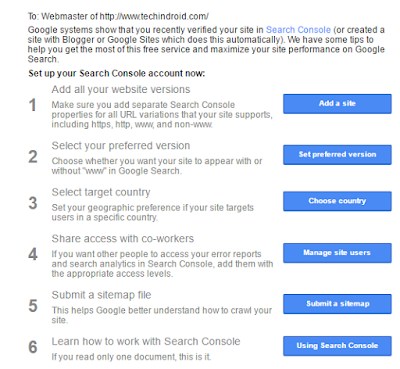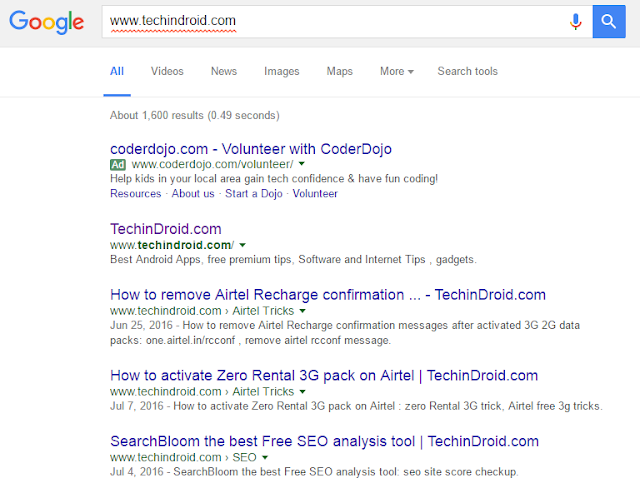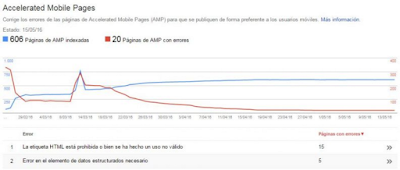Speaking of Google Webmaster Tools Search Console (months ago) is talking about one of the absolutely essential tool for any marketing campaign in general and technical positioning in particular, and even all webmasters who really have the luxury of calling themselves as such.
As it is such an important tool and seeing that he had not yet contributed my bit in this blog, today ReAplicante you have at your disposal a comprehensive guide to what the tool and its features.
To give it more simple and can consult whenever you want this text as a document header I have divided into three distinct parts:
- First let’s see what Google Webmaster Tools.
- Second we what are the first steps.
- Finally we’ll see what information you can get from it and what are its key points.
- What is Google Webmaster Tools?
Google Webmaster Tools (GWT) is the classic name Search Console, in fact, it remains the same with another trade name.
In other words, right now to Google this platform is called “Search Console”, but for many years has been called Google Webmaster Tools and all they did was change the name.
The tool itself gives a lot of data coming directly from Google among those about the appearance of search traffic or how Google crawls your site, and precisely as it gives you information from the sitemap to the estimated positions the search is highly recommended for virtually all profiles.
Moreover, as we will see right after this point its implementation is really simple and will not take more than five minutes, taking a lot of advantages from the first minute.
As I do not want to bore you with more introductions, let’s get into flour:
Contents
Beginning the journey with Google Webmaster Tools
If you still have never implemented Webmaster Tools , quiet, I will teach step by step how it is done and you’ll have no science.
Conversely, if you have already implemented this tool, I invite you to go to the next point, we are not to waste time.
Verifying your site
The first thing to do to have data Search Console is to have a website and verify ownership, for this is very simple, you just do:
Step 2. Click “Add a property“, top right:
Step 3. Put the URL of your site, you just have to write it.
Step 4. Select the verification method.
Here are several available, which are:
- Upload an HTML file to your server.
- Add an HTML tag.
- Access the domain name provider.
- Using Google Tag Manager.
- Use your Google Analytics account.
All systems are valid, but one that is much simpler than the rest: If you do this verification using the same account with which you entered the code Google Analytics , you just have to use that option, click “Verify” and ready.
It is the option that I recommend from the bottom of my heart, and besides you “I force” to install Google Analytics on your site and start measuring conditions.
There is an extra way of checking for some time and although it leaves them to all accounts, we also wanted to comment: It is neither more nor less than verify Search Console by tag Google Tag Manager.
If you do not know, Google Tag Manager Google is another platform that lets you add a lot of tags for Google Analytics measurement without having to touch the code for the site, a Wonder Whore ™ that not many people use.
With that your site is already verified, and you’ve taken throughout the process as much as five minutes, right? Then move on.
Submit your sitemap to Google webmaster tools
Now that you have your site verified first thing to do is submit your sitemap to the tool, as this will give you all index data you can imagine, improving the visibility of your site by several orders of magnitude or, in other words: you’re already taking!
To do so you have very simple and also tell you how step by step:
Step 1. In the left sidebar go to “Trace” and then “Sitemaps”, as you can see in this image:
Step 2. On the screen that leaves you more or less top right have a button that says “Add or Test Sitemap” is right there where you must give.
Step 3. You will get a pop-up with the URL of your domain so you put the path to your Sitemap, something like this:
Step 4. Just put the URL of your sitemap and you have it ready.
Now, what if you have no idea if you have a sitemap or do not have it and where is it ? Do not worry the least, some time ago I made a post about where I teach you how to create a WordPress & Blogger sitemap and upload it to Webmaster Tools, you can see it here .
Let’s say that this part of the implementation is ready, now we have to go further to see what key points of this tool, are you game?
Key points and information GWT
Now that you have Search Console is implemented we take full juice to this tool, and for that we go see one by one all sections of it, so you can not be absolutely nothing without trying.
In order to improve your experience when you get to work, I will follow the same order as you appear on the menu that you have in the sidebar, so you do not have any complaint and will serve as helpful as possible.
That is, first we will look at the key points of the Dashboard, then we will search aspects to continue with traffic, and finally index tracking.
Google Webmaster Tools Dashboard
In the main Dashboard tool as you enter you will see four very interesting widgets:
The first has as main reference messages since notifies you of special alerts or even manual penalties, is you say, if your site is no longer accessible by a server down, if you make a big change and start dating mistakes 404, or if Google suspect you are buying links.
At the lower end you can see three different:
- Crawl errors , that does not stop being a summary if your server is up and everything goes properly.
- Search Analytics where you can see a rough estimate of the traffic you will receive from search engines, which itself has quite correlation but then gives you some surprises that we will see later in this guide, hence leave this copy image.
- Sitemaps , where you will see a summary of the status of your sitemaps, how many URLs sent and how many are indexed, with its counter errors and warnings.
These you the story so roughly that it is well explicadito each in its corresponding point, but I want you go making an idea.
Console messages Search
The first stop of the menu has to do with the messages it gives you Google on the status of your site , something that interests you whether you are the person who takes the part of online marketing like part of the team of webmasters of the company.
The messages themselves that offers Google are of several types, you all have grouped into five categories:
Accessibility errors
Such messages are those that owe more to worry the webmasters, because they have to do with such beautiful things as fallen servers , either tostamientos or errors 500 or increased 404 pages, usually the result of migrations not quite well done.
The good part is that the messages are clearly identified and notifies you if one type or another.The bad part is that usually takes a few days to jump the message, which may be too late.
Overall, this serves to see when you will fall and when the host is going to hurt, but not to prevent it. A monitoring system over.
geo-targeting
Today, you have a single language site is multilingual or your project has to have a geographical orientation.
To this end, in addition to the label hreflan to explicitly tell the search engine each page in which language is, you have a specific section in Search Console so that the search engine will even clearer, and that the only thing that will do is that you sumes.
Well, Google warns you each time you change the geographical orientation of the site, so there is no doubt.
Notifications
How could it be otherwise, self Search Console notifies you via message notifications typical program, such as when you validate your account when this validation is disabled, when you add users and so on.
I will not go into more stuff here because it seems pretty self explanatory.
Error correction
This part not only see important, I like a lot: Webmaster Tools lets you know the errors typical that may occur in the variables monitored at SEO level, for example:
- Search Console notifies you when you have errors in the sitemap, something of vital importance for visibility, you see the point you touch.
- It also alerts you if you got errors in the implementation of the AMP, the new standard to have superfast mobile pages.
Overall, a little gem.
Penalties. Yes, you heard right
Google also notifies you via Search Console penalties on your website . But of course, you know you that the Google Universe ™ everything is not as easy and simple as it should, so this one is tricky …
The message usually sends one type there “there is a possibility of taking manual action against your site because of strange behavior” that in román Palladian would something like:
We think you’ve caught skipping the torera the Guidelines of Google and are studying manually whether or not penalize you.
The nice part about this is that this message can happen:
- Before you penalize, ie, you have a little margin before you fall, but not much.
- Once you have been penalized, ie, come to confirm your fears when you see your traffic has fallen.
- Once you have been penalized and then even take away the penalty, which will be fun, because you will walk with the fly behind the ear and once you recover your traffic, you see the message.
- Finally anything can happen also very interesting: Google can penalize you and not send anything.
How are messages Search Console?
To show you what you face, I copied what would be a typical message, they all follow the same structure
Search Appearance
Next on the menu are five aspects that have to do with the aspect of search , which also have heard about it a lot of times as “snippet search” and so in the words of homespun not stop be:
As seen your results when it comes out on Google.
And so you have a catch:
Within this menu you have five different sections that we will be seeing one by one, they are:
- Structured data.
- Marking data.
- HTML improvements.
- Sitelinks.
- Accelerated Mobile Page
Within these four sections to which more attention must give a priori is that of “HTML Improvements”, because thanks to it you will be able to detect how many short meta descriptions, long or duplicate you have on your site, and even know the URLs where you have these problems.
In addition to this you will see problems as indexable content or title issues, and precisely why it is so, so important.
The rest, not going to cheat, are much more freaks but are solvable faster way other ways, however, let’s go one by one, as I said at the beginning:
structured data
The structured data as such are neither more nor less than everything that has to do with enriched formats, Schema.org and many beautiful things.
As you advance it is that, which has made this world and the change in nomenclature, plugins and so on is very difficult not to have a lot of mistakes at this point, especially if you have a type site blog with lots of items .
On the other hand, I also tell you that if you have an eCommerce This section gives an extra little step in importance, because all traffic that can lead to sales pages (ie, product descriptions) you are very interested, and they should all have the structured data perfect s.
The good part of this section is that Search Console lets you know how many errors you have and what type, and can even download and go deleting them, I put a screenshot of how my blog today:
You see, in today TechinDroid most errors are in the Hentry tag, which is basically a microformat other groups within it.
enriched Cards
Enriched cards has a lot to do with the rich snippets, also called microformats that you will also see in the next section.
But hey, what we are : Here it is what Google does offer information on how you see these rich on your site formats , so you can check if you have errors.
The bad part is that Google will not give an extraordinary information if you have serious mistakes, but hey, it’s always good to know at least, do not you think?
The portion of rich formats, rich snippets, rich cards, rich cards or whatever you want to call is important because it gives you more visibility in the search, and of course, ultimately is what we all want.
Total, in a nutshell:
Do not let it happen. No way.
Data marker
I will not be fooled: the data marker was useful 3 or 4 years ago, when still the standard microformats were not widespread, but once was enough Schema.org gallons and the rest were grouped beside this finally, they stopped making sense.
In these times, this tool made sense because you get all microformats allow you wanted in each URL and also see how they would be in Google, which saved a lot, a lot of work.
Then what happened had to happen: The market matured, left plugins rich formats, webmasters were relieved of work and today you can get the rich snippets quietly from the back of WordPress.
Come on, that if you use it, is because you want (and have plenty of time).
HTML improvements
This point is very interesting, because under anodyne title “HTML Improvements” a simple analysis that usually do quite pupita hides:
Google detects problems in your title tags, description and non – indexable content, and this point is pure when making a gold audit SEO .
This point Webmaster Tools could stay here and it would be very good, but it goes a little further and, if you click on each item, gives you a list of URLs where you have the problem, to get it you can download and solve it going fixed shot.
And yes, now much cooler, right?
I leave a screenshot so you can see how this functionality is that there is always a mistake (of course!):
If you notice, the concept of “short meta descriptions” is in blue and has a total of 29 pages. Well, if I click on it will give me a list of the 29 pages in question so that he could investigate them one by one.
How will this help in optimizing your site?
Binding sites
Again, this section is not more than a sketchy translation of ” Sitelinks “, a concept that is in the search since the world began .
If you’re a little layman terms SEO is concerned, certainly you not know what I’m talking about, but it is neither more nor less than the outstanding bonds when a user searches for your brand on Google.
For example, if you put in the search “TechinDroid”, this is what you would first result:
Precisely the six links that are below the snippet of the home of this blog is what you can play in this section Search Console.
Again, it sounds nicer than it sounds, because I have to confess something important:
Google usually puts links that gives real wins, regardless of whether you told what links you want to appear or not.
I also tell you one thing today becomes quite more case a few years ago and, in fact, I’ve seen a real evolution in this respect since I started working in SEO in the distant year 2,008, but still do not put Google hopes that follow your dictates.
Prompted are.
Accelerated Mobile Page, also known as AMP
It is the latest change Search Console, and one that has caused me more happiness in recent times in terms of on-page SEO.
I also tell you one thing: If you’re not into the everyday news regarding SEO, surely you have not heard anything, and that’s why I want to comment on this discovery.
Earlier this year 2,016 Google launched a news: I was going to incorporate a new standard to have superfast mobile pages, with special emphasis on the news, was like “a mobile version with uppers”, with very little design but very powerful.
Well, a few weeks in the Webmaster Tools appeared this concept that allowed you to make mistakes of this new standard and, as has become usual, at first there was all fine I should, but I do now.
How is this AMP in the search?
Well, you will not give much badgering, are these kinds of results:And to get them on your site you have it very easy if you have WordPress, you just have to download a plugin called AMP , work Auttomatic ( external link, you go out … ), turn and throw you to sleep, having greater visibility in the Google news section (presto!).
And how does it look in Webmaster Tools?
For in the section Accelerated Mobile Page (AMP) what you see is a graph of errors and correct things in the last three months, something like this :
As you can see, in this case I started to implement AMP since the beginning of the standard and, although at the beginning the plugin does not work too well (note the peak of errors in February, very early in the graph), there was an update on plugin that I was talking about you and today works as silk.
Search Traffic
For me the tab search traffic is undoubtedly the most chicha has everything Search Console as aconcept, and this is where I spend most of the time.
- Search analysis.
- Links to your site.
In total there are six sub-tabs, so you do not miss me:
- internal links.
- manual actions.
- International segmentation.
- mobile usability.
And, as in the previous case, we will go one by one so do not miss
Search Analytics
It is the best there on a day to day within Google Webmaster Tools because it allows you to havespecific data Key Indicators (KPIs) as important as clicks, impressions, CTR or position for a lot of parameters.
It is in this manner:
Security issues
It is a point and is just the best thing ever have to spend, but just in case you commented:
Here Webmaster Tools Google says you if your site has any problems security type you have something dodgy on your server detected, you know, the typical display of “This content is not sure” that scares users and kill your ranking .
So you know, if you have any problems with malware or phishing, either intentional or I’ll have strained not to have your Content Manager actualizadito well, this is where you will come out the notice.
As you can see, Google Webmaster Tools is much more than a tool complete for marketing, being totally mandatory use by the quantity and quality of information it offers.
In fact, I dare say that you should not start any web project without this tool properly configured without spend at least once a week for her to see what is afoot.
Finally I want to ask you something: Do you use Webmaster Tools? For what? Hurry up and said, today I will respond to all comments, take advantage!


![Google Webmaster Tools [Complete guide] Google Webmaster Tools [Complete guide]](https://1.bp.blogspot.com/-YHVfXuYCuDM/V5Rhc6hvohI/AAAAAAAACVA/nxgqKVs36iYbVW-VKmrqABnObm96UfHcwCLcB/s640/Google%2BWebmaster%2BTools%2B%255BCompele%2Bguide%255D.png)
![Google Webmaster Tools [Compele guide] Google Webmaster Tools [Compele guide]](https://2.bp.blogspot.com/-iFcGDQutZDc/V5RjC82fNXI/AAAAAAAACVQ/C3jqIQDlS4c7rRRL5LHiooNU0qr8J3okACLcB/s400/Screenshot%2B%2528130%2529.png)
![Google Webmaster Tools [Compele guide]](https://2.bp.blogspot.com/-GeH-rXB0RaQ/V5RO8kE7H7I/AAAAAAAACTE/eAryvkxdwTMUj0EFRj7--vb8d_5zVznOgCLcB/s640/Screenshot%2B%2528112%2529.png)
![Google Webmaster Tools [Compele guide] verify your site](https://4.bp.blogspot.com/-ZnJZ7csac9E/V5RPvVMIQaI/AAAAAAAACTM/BhEgB2Cv8Y0UCkaCfS7snChlD69C0dbKwCLcB/s640/Screenshot%2B%2528113%2529.png)



![Google Webmaster Tools [Compele guide] Dashboard](https://4.bp.blogspot.com/-fk1D56-2l6c/V5RUZT5LIPI/AAAAAAAACTo/-RQCkmIr50U_Dc0tMkX6YkOnYWstCOWQACLcB/s640/Screenshot%2B%2528118%2529.png)


![Google Webmaster Tools [Compele guide] Structured data](https://1.bp.blogspot.com/-rOkroAwsBKI/V5RXTXVdFTI/AAAAAAAACT8/IcaPCyAA--suTycNx7LuiVlRWKwMleIxQCLcB/s640/Screenshot%2B%2528121%2529.png)




![Google Webmaster Tools [Compele guide] Search analytics](https://1.bp.blogspot.com/-OJbGislrXrY/V5RdlSKF5YI/AAAAAAAACUk/MI1kMEHtqys9-VIdvp_fxWOB5AqsFR-rwCLcB/s640/Screenshot%2B%2528126%2529.png)